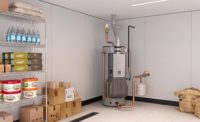At Biaggi’s Ristorante Italiano, one good serving deserves another.
The Bloomington, Ill.-headquartered upscale Italian restaurant chain made the call in September 2013 to substitute two ineffective and continually malfunctioning 100-gal., domestic water heaters at the company’s Deer Park, Ill., location.
Then, after a proficient — and most importantly — cost-effective conversion at Deer Park, Biaggi’s went ahead and greenlit the same job in December 2013 one hour southwest at its location in the Chicago western suburb of Naperville. Biaggi’s operates 22 locations across 10 states.
In the northern Chicago suburb of Deer Park, the original water heater could barely handle the restaurant’s dishwashing demands and tanks were being replaced about every three years. Gregg Bickus of Lockport, Ill.-based Bickus Plumbing thought the eatery would be best served with tankless water heaters.
“The units that were in place before were performing,” Bickus says. “But, there was a consistency issue and there were maintenance problems.”
The Biaggi’s brass agreed and had four Navien NPE-240 units installed in cascaded fashion. The restaurant now has instant access to hot water through a buffer tank and the recirculating pump. Bickus notes the four units work in concert and prevent a cold-water sandwich, where cold water is sent before the heater reaches the appropriate temperature.
Bickus worked with Navien’s engineering department for certain elements of the retrofit. “Navien provided me a drawing for the Deer Park location,” Bickus says. “It showed how to pipe the system. It was pretty simple.”
In addition, the old 100-gal. tanks were costing both locations in other areas such as gas and energy. The new units do not have to continually start up around the clock to keep the water warm.
“The tank heater had to fire up to maintain its main temperature,” says Mark Brickey, with Romeoville, Ill.-based manufacturers representative Metropolitan Industries. “Even when there was no one in the restaurant, such as at 2, 3 or 4 in the morning, those tanks are firing up. Saving energy and gas, that is secondary for Biaggi’s. The need for hot water trumps everything else, but it is an added benefit.”
The Navien NPE-240s feature a computer system that monitors and adapts to the hot water needs for each location.
“These NPE units have a computer system that learns the application’s patterns and it will start recirculating water 30 minutes before someone arrives for work in the morning,” Bickus explains. “At Biaggi’s, the pump will run – when needed – from 7 a.m. to 11 p.m.”
Stronger together
The four NPE tanks are linked via cascading technology that provides both Biaggi’s locations with all the hot water needed on-demand and each unit can work on an equal pressure basis.
There was no need to adjust the venting for either location. There were two inlet and exhaust vents already in use and those were cascaded during the retrofit, making for a nicer design and plenty of venting capabilities, Bickus adds.
By cascading the units at Biaggi’s, it controls the amount of use the water heaters face while providing all the performance needed to run at the most important times for business.
“When a unit gets up to 80% capacity, another one will come on to help meet the flow and demand required,” Metropolitan Industries’ Brickey says.
Brickey helped Biaggi’s and Bickus complete the job. “They’ll both ride up to about 80% and then the third unit will come on. It keeps the flow more even so there are no spikes or drops in water temperature,” he says.
The four units should not have to run at the same time to meet the full demands at Biaggi’s, but Brickey says having optimal operational conditions during peak demand times was one of the key goals of the projects.
“At Biaggi’s, its peak is when every sink and every fixture they have is running with hot water simultaneously,” he states. “When the tank goes down you have to immediately service it because that is their lifeline. A lot of restaurants would have one single tank and that would make it worse. Biaggi’s recognized that and now they have multiple tankless units.”
Chef recommends
Justin Nyeis the chef partner at the Naperville branch and continues to work closely with Bickus on Biaggi’s plumbing needs. Nye was not working for Biaggi’s in December 2013 when the Navien tankless units were put into operation. And when he first toured the location and saw them, Nye was skeptical.
“I was shocked when I saw the tankless water heaters,” Nye recalls. “At first I was a little speculative of the install because every place I’ve worked there are one, two, sometimes three of those huge tank water heaters.
“But, they work really well and there have been no issues with them. They are easy to work with, too. I believe if I wanted to, I could work on them myself. I am not going to, obviously, but I really enjoy having them here.”
Nye estimates his restaurant will seat anywhere between 600 and 700 people during its peak business hours – dinnertime on Friday and Saturdays.
The average ticket per plate at Biaggi’s is $25, making a conservative average Friday and Saturday night worth $15,000. Nye could not imagine what it would feel like if the restaurant had to close its doors because of a lack of hot water.
“I know with those big tanks that if something goes down it can really throw you for a loop,” Nye states. “When I worked at a different restaurant in Arizona we just could not get the hot water up and running. We had to shut down with a couple of hours left in the shift.”
When Nye worked in New York City, he recalls seeing a restaurant’s management taking other extreme measures to avoid having to turn away business because of a lack of hot water.
“We literally had to have someone boil water just to stay afloat,” he says.
In-and-out
Bickus and his crew were able to complete both the Deer Park and Naperville jobs over the course of one night.
“This was not an emergency project where the restaurant did not have hot water,” Bickus states. “As soon as they closed the restaurant for the night we came in and got to work.”
The crews got the cold water lines up and running first in case the retrofit was not completed in time before the restaurant would open the next day. Bickus and his team picked up an advantage on both jobs because the previous water heaters were already high-efficiency units and the Charlotte Pipe PVC piping already was installed.
“They have PVC through and through,” he states. “You just have to mount the new units and attach the piping. PVC is cheaper, available everywhere and all the plumbers use PVC fittings.”
The installations at Biaggi’s required a backflow preventer and Bickus put in a Watts Water Technologies unit. The NPE-240 water heaters have an internal recirculation pump which is the only thing that acts as a “tank.”
“Normally, when you install a water heater with a backflow preventer you put an expansion tank between the cold water inlet and the tank,” he states.
During the night in Deer Park, Bickus and his team did have trouble getting the internal recirculating pump up and running properly. The issue required an early-morning call to the technical staff at Navien.
“They walked us through it,” Bickus says. “It was no problem at all then.”
Brickey says it was a treat to work with a company such as Biaggi’s. The restaurant chain showed the initiative to take care of an issue that now will make its locations run smoother and more efficient.
“It was nice to work with somebody that wants to do the project right,” he states. “They probably could have got the job done with one less heater or cut a corner here or there, but they wanted to do it right and make sure they had backup. Some customers want to do bare-bones, absolute minimum. But Biaggi’s said: ‘No. We want to have some redundancies for maintenance shutdowns or stuff such as that.’ Biaggi’s is a good firm to work with.”
HELPFUL LINKS:







